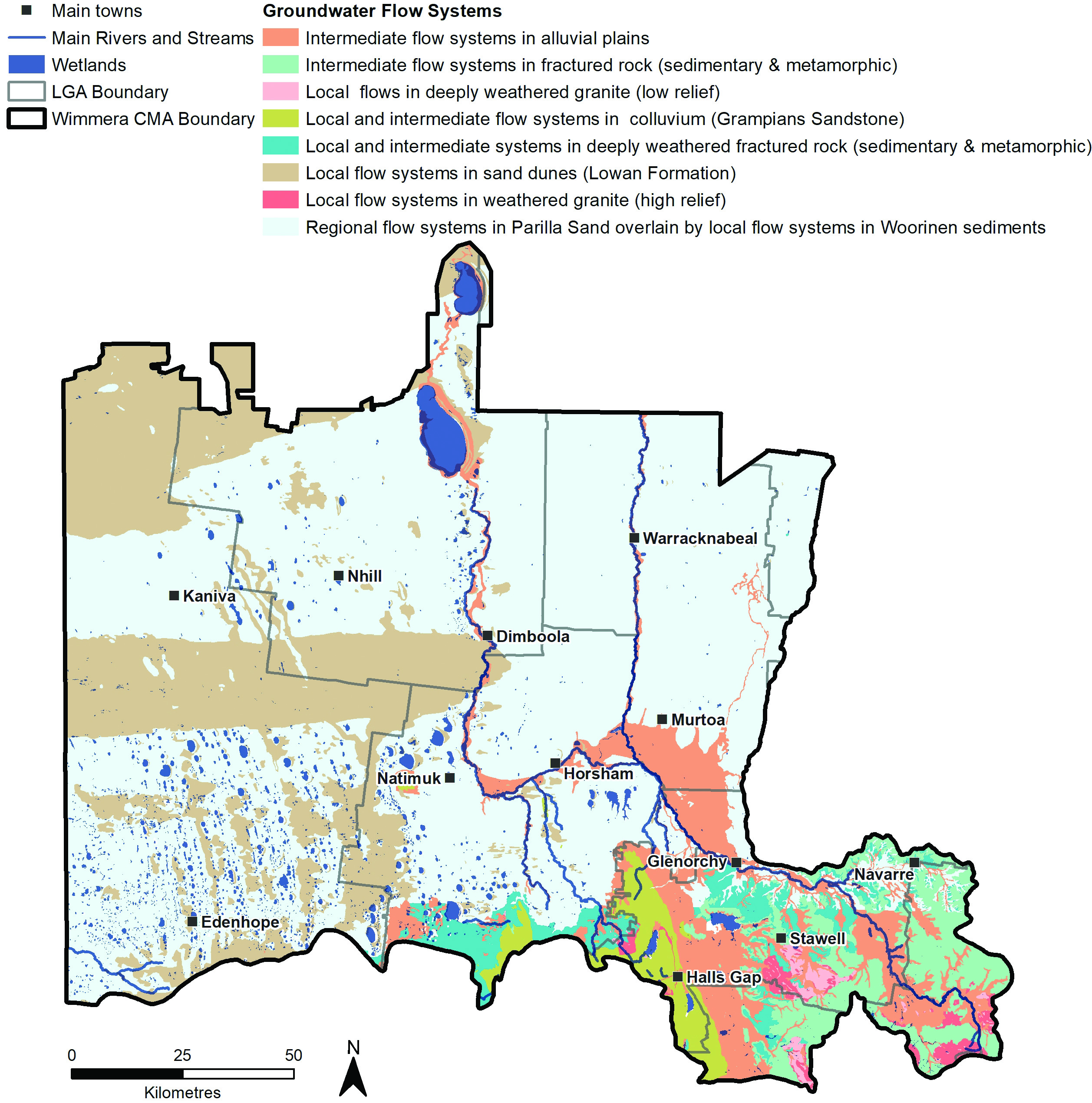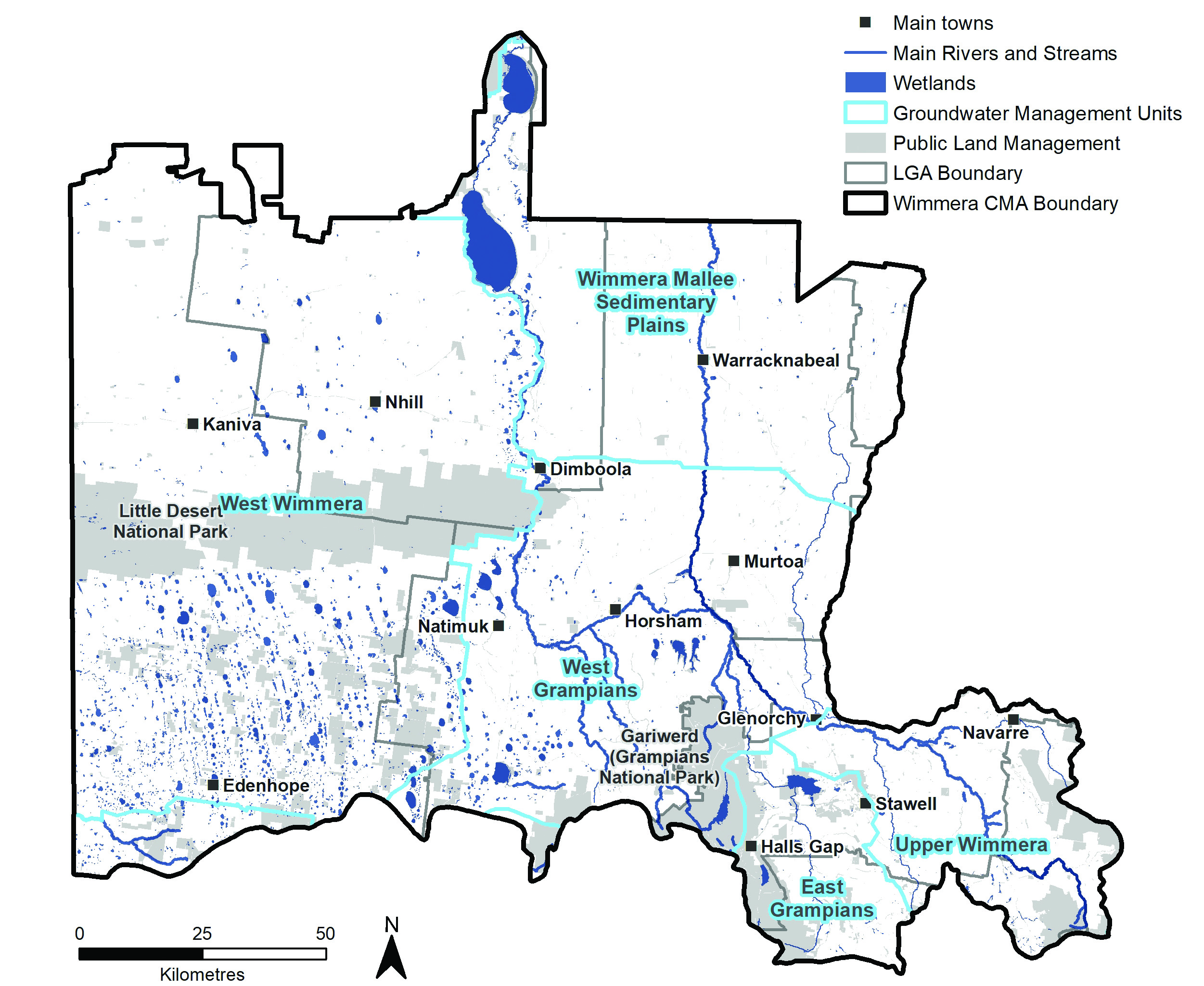| |||||
The characteristics of groundwater in the Wimmera are a function of the underlying geology which in turn influences groundwater quality and yield. The Wimmera’s groundwater is contained in layers of sedimentary sands, gravels, clays, limestone and fractured rock. Groundwater systems can be grouped into groundwater flow systems based on their characteristics. In the Wimmera, groundwater flow direction mirrors that of surface water, generally flowing from the southeast to the northwest.
For management purposes groundwater resources in the Wimmera are zoned into the following areas:
- West Wimmera Groundwater Management Area (GMA)
- Wimmera Catchment which includes the following groundwater management units:
- Grampians East
- Grampians West
- Upper Wimmera
- Wimmera Mallee Sedimentary Plains.
A 2009 West Wimmera socio-economic study investigated the value of groundwater for irrigated and intensive livestock systems. Combined with dryland systems reliant on groundwater for stock and domestic use, they were estimated to represent 40% of the value added in the agricultural sector of the West Wimmera GMA. The regional impact of the economic activity generated by using groundwater is in the order of $121 million per year.

Groundwater flow systems in the Wimmera

Wimmera groundwater zones
The analysis found that groundwater is an extremely important and valuable resource to the community of the West Wimmera GMA being the only significant source of water in the region.(17)
Groundwater also provides water to groundwater dependent ecosystems such as saline wetlands in the Natimuk Douglas chain of lakes and rivers and streams where the groundwater meets the surface.
There is also good quality groundwater emanating out from Gariwerd (Grampians National Park).
In parts of the Wimmera Groundwater Catchment, particularly in the north, groundwater can be viewed as a threat due to its high salinity and impacts on waterways and low-lying land. For this reason, it is not often used as a resource.
Assessment of current condition and trends
There has been a great deal of effort undertaken by Grampians Wimmera Mallee Water (GWMWater) to better understand groundwater resources in the Wimmera and to establish mechanisms that work towards sustainable management and use.
The Irrigation Development Guidelines – Wimmera are designed to manage any potential impact to the environment or third parties.
West Wimmera
Declining groundwater trends in the Murray Group Limestone Aquifer were observed in the early 2000s, particularly in the Neuarpurr zone of the West Wimmera GMA where there is concentrated extraction of groundwater for irrigation. Groundwater levels elsewhere were generally stable. The principal cause for the declines were extraction rates within Victoria and South Australia exceeding the rate of recharge or throughflow. It had been previously thought that the resource was replenished by modern recharge. However, research and observations over the years identified that, for much of the GMA, the resource is very old and recharge occurs at a slow rate. Recharge in some areas is less than the current rate of extraction.
The maximum volume of water that can be licensed for extraction in an area or water system like a GMA is known as a Permissible Consumptive Volume (PCV). The PCV is set by the Victorian Minister for Water. The PCV Order for the West Wimmera GMA outlines the total volume that may be taken in a zone or sub-zone. Domestic and stock use is not included in the PCV. Current entitlements total approximately 52,500 megalitres per year. Groundwater use has generally been less than half of the total entitlement volume.
In 2011 GWMWater published the West Wimmera Groundwater Management Strategy based on the understanding of the resource at the time. This strategy established local management rules aimed to ensure that groundwater is managed in an equitable manner to achieve the long-term sustainability of the resource. It aims to achieve a stable trend in groundwater level while maintaining the benefits that groundwater provides to the region.(18)
In 2018 GWMWater commissioned a technical review of the West Wimmera Groundwater Management Strategy. The review assessed the resource condition and the effectiveness of the local management rules in delivering on the objectives of the strategy. It showed that the local management rules established in 2011 have been effective in showing some stabilising of groundwater levels. In response to recommendations from the review, the strategy’s management rules have been consolidated into the West Wimmera Local Management Plan 2019, with some adaptations to improve their effectiveness in protecting the resource.(19) While some signs of stabilisation have been seen, any significant increase in the volume of groundwater extracted, may result in a further decline in groundwater levels. Climate change is also a significant risk due to reduced recharge and the potential to drive an increase in use because of reduced rainfall.
Wimmera Catchment
The Wimmera Catchment Surface Water and Groundwater Local Management Plan provides an outline for how GWMWater manages the groundwater and surface water resources as the delegated Authority under the Victorian Water Act 1989.(20) The plan area has been split into four groundwater catchments to provide a more detailed summary of the groundwater resource. As groundwater has not been intensively developed, there has been no requirement for the declaration of a PCV for the Wimmera Catchment.
Grampians West
Relatively minor groundwater extraction has occurred in this area to date, with 19 groundwater licences totalling 7,700 megalitres per year.
There are no registered groundwater dependent ecosystems in the area. There are groundwater and surface water interactions in the stretch of the Barringgi Gadyin (Wimmera River) from Horsham to Dimboola. Saline groundwater continues to discharge into the Barringgi Gadyin (Wimmera River) at this location.
Groundwater levels vary according to rainfall patterns and associated recharge.
Groundwater quality is variable across the area with the best quality groundwater near the slopes of the Grampians mountain range.
Grampians East
Groundwater in the East Grampians area has been sparingly used as a water source due to the high availability of surface water throughout much of the year. There is 551 megalitres of groundwater entitlement licenced in the East Grampians area. Of that volume, GWMWater holds 220 megalitres for the Mount William wellfield for a supplementary urban supply to the townships of Willaura, Moyston, Lake Bolac and Wickliffe outside of the Wimmera region.
Aquifer recharge throughout this area is directly from rainfall and runoff. Evapotranspiration is a major contributor to groundwater loss.
Upper Wimmera
Groundwater in the Upper Wimmera area has not been used to any great extent due to the limited availability of water with relatively low salinity (<1,500 uS/cm) and general trend to preference the use of surface water. There is 474 megalitres of groundwater entitlement licenced in the Upper Wimmera area.
Evapotranspiration is a major contributor to groundwater loss where the groundwater is shallow.
Wimmera Mallee Sedimentary Plains
Groundwater use in the Wimmera Mallee Sedimentary Plains is very limited due to the high salinity of the groundwater.
The main groundwater extractions in this area have been for heavy mineral sands mines located south and south-east of Ouyen (which have since ceased) and a salt production business on Lake Tyrell in the Mallee CMA region. Groundwater quality is unsuitable for basic domestic and stock use throughout much of the Wimmera Mallee Sedimentary Plains area.
Major threats and drivers of change
Intensive development of groundwater can potentially impact on its sustainability and availability due to declining groundwater levels. Declining levels, if left unmanaged, may cause supply issues to domestic and stock users requiring deepening of bores or pumps to maintain supply.
The Department of Environment, Land, Water and Planning (DELWP) and GWMWater have a rigorous process for monitoring and managing licensed groundwater resources. DELWP record information on all registered groundwater bores. Specific bores are monitored throughout the region, collecting data on groundwater levels. This information is recorded in DELWP’s Water Management Information System. This allows authorities and users to modify management to ensure the resource is maintained.
The groundwater resource can also be impacted by interstate management and use. For example, the groundwater resource in the West Wimmera is also used in (shared with) South Australia.
Climate change has the potential to impact on groundwater held in storage and groundwater levels. As the climate dries and heats up, less rainfall or surface water has the potential to recharge groundwater aquifers, due to less rainfall in general and increased evapotranspiration. The timing of rainfall, or lack of it, may also lead to an increase in groundwater extraction for use and the potential to result in a decline in groundwater levels.
Land-use change can also impact on recharge to aquifers and drawdown water tables. For example, forestry plantations can intercept a greater volume of groundwater compared to pastures, preventing it from entering the water table. Plantations can also access more water from the water table as the root depth of large trees penetrate much deeper than that of pasture.
Increased extraction along with natural groundwater flow processes may lead to increasing salinisation of freshwater aquifers.
Landholders can maximise their water use efficiency by improving their ability to understand their systems. For example, a better understanding of soil moisture can mean that watering only occurs when and at the volumes required. New technologies can assist in these decisions and more efficient application of water.
The groundwater resource may be threatened by the presence of failed or failing groundwater bores, particularly where the fresher aquifer such as the Murray Group Limestone is overlain by the saline Parilla Sands aquifer. As the steel casing corrodes, it allows water from the saline Parilla Sands aquifer to enter the fresher limestone aquifer via the casing, resulting in contamination. Capping and decommissioning of old bores is important to protect the water quality and integrity of the groundwater resource.
Point source pollution is another issue threatening water quality in the Wimmera’s groundwater systems. This can be experienced as leakage from septic tanks and underground petroleum storage systems or leaching from landfills and former industrial sites. Data concerning these issues is virtually non-existent, although its impact is believed to be small. More recently there have been concerns about the potential contamination of groundwater from illegal chemical dumping. While there is no evidence to suggest this form of dumping has led to the contamination of groundwater, the risk of this type of activity remains.
Drainage bores are also known to have been historically operated in some parts of the catchment. This involves bores being constructed to drain surface water from waterlogged areas into the subsurface mediums, most likely underlying aquifer systems. This has the potential to transport poor quality surface water into the groundwater system, introducing contaminants like sediments, farm chemicals and nutrients.
Desired outcomes for the future
Outcomes to be achieved in 20+ years
- The knowledge and experience of First Nations people is informing groundwater planning, management and delivery in the Wimmera.
- Stock and domestic users access to water supply is not impacted by licensed extraction.
- Licensed groundwater users have access to water supply.
- The quality of groundwater is protected.
Outcomes to be achieved in 6 years
- Ongoing collaboration and two way learning in groundwater planning and management by supporting and strengthening partnerships with First Nations people.
- Current management restrictions are maintained until there is evidence of groundwater levels stabilising.
- The groundwater resource is understood in developing areas before it is allocated.
- Landholders access better data and knowledge to inform water use decision making.
- New groundwater irrigation proposals comply with the Wimmera Irrigation Development Guidelines.
- Groundwater users manage risks to water quality by decommissioning unused groundwater bores.
- Risks to groundwater from pollution are understood.
- Groundwater monitoring, investigation and reporting is continually reviewed to identify opportunities for improvement.
Complementary Plans
West Wimmera GMA Groundwater Management Strategy
This strategy was prepared as an adaptive management document to ensure that the groundwater resources in the West Wimmera are managed with the goal of long-term sustainability. The management rules from the strategy have been consolidated and updated within the West Wimmera GMA Local Management Plan. They seek to further define the management arrangements in response to improved understanding of groundwater resources and the criteria for assessing and implementing any new restrictions.



